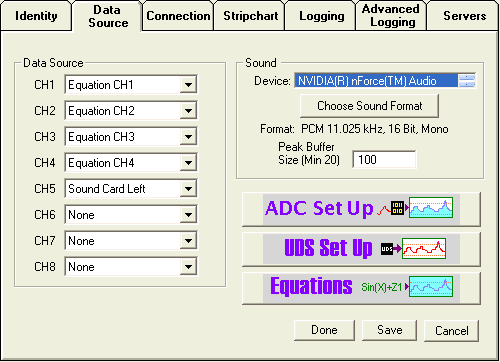Radio Eyes can remotely trigger Radio-SkyPipe data collection software. The Pro version of Radio-SkyPipe is required. Radio Eyes sends observation tasks to the Telescope Control Point Program . One of the properties of most types of Radio Eyes Tasks is "Use Radio-SkyPipe". If this parameter has a value of True, then before the Telescope Control Point Program executes any move commands for the task, it will try to open an administrative communication path to the Radio-SkyPipe program. Radio-SkyPipe must of course be configured to accept remote administration for this to work. SkyPipe must be set to Allow Remote Admin. The Telescope Control Point program can command Radio-SkyPipe in the following ways:
When you create an observation task in RE you can check the Run Radio-SkyPipe for this Task checkbox and the Task Editor panel will expand to show the available options.

The three Admin options at the top of the Radio-SkyPipe Automation Parameters panel are required.
The Profile File is optional, but when present must point to an existing profile file in the Radio-SkyPipe application directory. You create the profile file from within Radio-SkyPipe. See the Radio-SkyPipe help pages for instructions on how to do this.
RA, DECL, AZ, and EL Channels
Below the profile text box notice four entries that allow for direct transfer of
RADEC and AZEL information into the SkyPipe strip chart. On the SkyPipe
end you must set up corresponding channels to record these values if you want
them.

In SkyPipe's Options/Data Source you would set up Equation Channels that
match the RADEC and AZEL channels you stipulated for this task. Then press
the Equations button on the same panel:

Now under the equation definitions you simply put MsgDataX where X corresponds
to the channel number. This is a sneaky little back door that you can use
to get data into the chart. Instead of using a real equation to calculate the
antenna position, SkyPipe will receive position information via the Admin
function from the TCPP which is keeping good track of this information
anyway. The data comes in as values for these MsgDataX variables.
Generally the data is only updated every second by the TCPP. Make sure
you check all of the appropriate Apply boxes before pressing OK. Then save
the entire SkyPipe configuration as part of a Profile. The name of the profile
you use is the same one you put in the Profile File textbox as described
above.
Run In Server Mode should be checked if you want to server out the SkyPipe data. If left unchecked, SkyPipe will be run in Stand Alone mode.
Check Publish if you want to make this a public data stream.
Stop chart when task ends is important. In most cases, you will probably select this option, however, it is possible that you would be setting the telescope to scan a certain position indefinitely, in which case you might want the program to keep collecting data even if Radio Eyes ends.
If you check the Save Radio-SkyPipe Settings as Default, you will be saving the contents of this configuration panel as the default for Radio eyes. It does not mean that you are affecting the default settings of Radio-SkyPipe itself.
You must set Radio-SkyPipe to Allow Remote Admin. Of course, the admin Password, IP, and Port settings must match those used by Task in order for the connection to be successful.